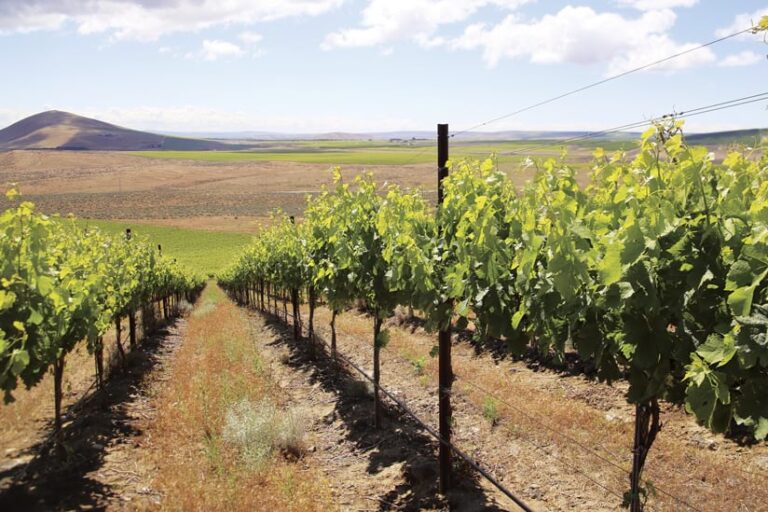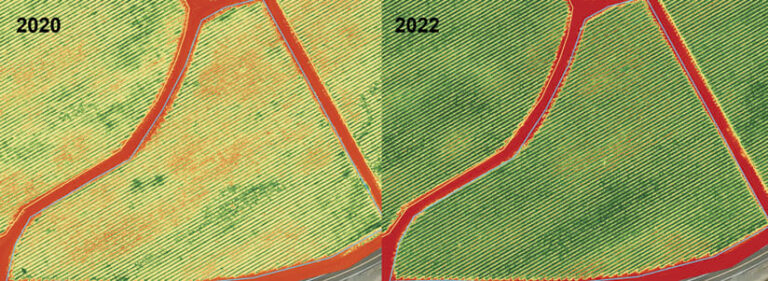Washington State is the second-largest producer of fine wine in the United States. Its vineyards thrive in the long daylight hours and warm, dry climate that are characteristic of certain regions in the state. But climate change is producing new challenges.
Shaw Vineyards manages 800 acres of property on Red Mountain, which carries the designation of being an American Viticultural Area. The vineyard supplies grapes to several well-known wineries while also producing its own vintages.

As the summer days in Red Mountain have steadily grown hotter, Shaw Vineyards and other growers have been looking for ways to improve their harvest quality and resource efficiency while optimizing water usage. To do this, Shaw Vineyards has turned to GIS and aerial imagery.
Gaining Insight Before It Blows Away
Esri startup partner Pollen Systems was founded in 2018 to help farmers grow better crops by leveraging aerial imagery, advanced agricultural analytics, and digital agronomy consultation services. Over the last five years, Pollen Systems has worked with vineyards, nurseries, orchards, and field researchers to help them use new technology to improve their data-driven decision-making.
Clients can gather data on their own or have Pollen Systems do data collection. Whichever data gathering route they choose, they can then view and act on the data via Pollen Systems’ PrecisionView Manager apps, which facilitate effective management of field issues based on the latest data. PrecisionView runs on ArcGIS technology, and using it doesn’t require having experience in GIS.
“To us, Pollen represents data, visible and invisible, that pervades farmlands worldwide,” said Keith McCall, Pollen Systems founder and CEO. “Pollen Systems harvests that data and turns it into actionable insight before it blows away.”
For Shaw Vineyards, PrecisionView offered a powerful tool to use for irrigation monitoring.
An Irrigation System That Needed Upgrading
The land that Shaw Vineyards cultivates is situated on a range of soil types, including silt loam and loamy sand—two different mixtures of sand, silt, and clay that, in general, hold moisture but drain well. With an aging irrigation system, Shaw Vineyards wasn’t able to deliver water to the vines at the precise intervals that are appropriate to each of the different types of terrain in its vineyards. Under these conditions, vines planted in sandier areas suffered greater heat stress while vines situated in silt loam often received excess water. This resulted in some rows having vigorous, flourishing canopies while others were severely wilted.
Additionally, the original irrigation system that Shaw Vineyards used often experienced leaks, which are notoriously difficult to identify from a field’s edge. It was impractical to have someone drive by each row during irrigation, trying to identify leaks. With vineyard canopies fully opened early in the season, this risked leaks going unidentified for days or even weeks.
Shaw Vineyards needed a fast and reliable leak detection solution to save as much water as possible. And once the new irrigation system was properly calibrated, staff at Shaw Vineyards wanted a way to measure the new system’s impact on vineyard vigor and uniformity.
A 360-Degree View of Vineyard Data
In July 2020, Shaw Vineyards began conducting monthly drone flights in a 68-acre trial area. This provided a baseline against which future irrigation management could be measured. A digital agronomy team at Pollen Systems then reviewed the aerial imagery and augmented it with crop-specific algorithms to identify potential issues that needed to be addressed with the grower.
After each data collection session, the team at Pollen Systems discussed the identified issues with staff at Shaw Vineyards to help guide their field management response. The growers were then able to use the observations stored in the PrecisionView platform to delegate tasks, such as investigating vines in stressed areas and fixing irrigation leaks, to field-based employees. The team at Shaw Vineyards regularly compared the multispectral imagery of its fields to identify irrigation leaks and changes in canopy strength and consistency.
“Receiving and processing raw aerial imagery without guidance could be very daunting for a grower,” said Drew Falabella, director of agricultural solutions at Pollen Systems. “But our solution is powered by ArcGIS Enterprise and doesn’t require any prior GIS experience to use. It’s an effective turnkey solution for agricultural professionals in need of a 360-degree view of their fields.”

The PrecisionView platform serves as a distributed computing and data storage system that allows staff at the vineyard to act on the insight that industry-specific experts at Pollen Systems garner from imagery and other remotely sensed data. The platform, which leverages Esri products such as ArcGIS Enterprise and ArcGIS Image Server, renders the analysis results as feature layers and charts that coordinate with aerial imagery. The advanced capabilities of Image Server allow the team at Pollen Systems to employ large collections of overlapping, multiresolution imagery and raster data from different sensors, sources, and time periods. PrecisionView web and mobile apps are enabled through ArcGIS Maps SDK for JavaScript and ArcGIS Maps SDK for Swift.
“We’re using Pollen Systems’ aerial flyovers to help promote vineyard uniformity and to quickly identify and address irrigation issues,” said Marshall Edwards, vineyard operations manager at Shaw Vineyards. “Our goal is to produce the highest-quality wine grapes possible so our customers can produce world-class Red Mountain, Washington, wines.”
With other customers, Pollen Systems is also employing Deep Learning Studio, an ArcGIS Enterprise web app, to enhance agricultural analytics and provide further insight into crop yield and quality.
Improved Vine Vigor and Uniformity
After using Pollen Systems’ solutions to track irrigation issues through the summer of 2020, Shaw Vineyards began installing a new irrigation system in 2021. Throughout 2021 and 2022, Pollen Systems continued collecting data to assess the irrigation improvements.
Each month, the digital agronomy team at Pollen Systems analyzed multispectral normalized difference vegetation index (NDVI) and normalized difference red edge index (NDRE) aerial data to monitor areas in the vineyards that had abnormally high vigor. This indicated likely irrigation leaks.
With this information, Shaw Vineyard’s field-based employees were then able to navigate directly to where the irrigation issues were marked on a map, reducing the time it took them to search for these spots on their own. They were then able to fix the leaks by replacing the damaged sections of irrigation hose. These efforts resulted in a 68 percent decrease in leaks between August 2020 and September 2022.
By early autumn of 2021, the vigor detected in NDVI data had improved by 22 percent on average, including in regions of the vineyard that were planted in problematic sandy soil. Canopy variability also decreased by 46 percent, indicating that while the vigor increased, the canopy became more uniform. Moving forward, staff at Shaw will continue to fine-tune the irrigation rates to balance the sandy and loamy areas for each season.
Shaw Vineyard’s new GIS- and imagery-informed approach to irrigation promptly began proving useful for managing the effects of highly variable temperatures. In June 2021, the northwestern United States experienced an unprecedented weeklong heat wave, and in 2022, there was a monthlong delay in the growing season due to cool temperatures. Thanks to the aerial imagery analysis that Pollen Systems performed, Edwards and his viticulture team were able to adjust their irrigation output to weather these conditions.
In 2023, Shaw Vineyards is scaling up with Pollen Systems to refine irrigation delivery across all 800 acres that it cultivates on Red Mountain, using both drone and satellite imagery. With data captures now occurring three times per month, Shaw Vineyards properties are optimally positioned to save field hours, promote vineyard canopy balance, and responsibly calibrate the irrigation system to meet each year’s production goals.

